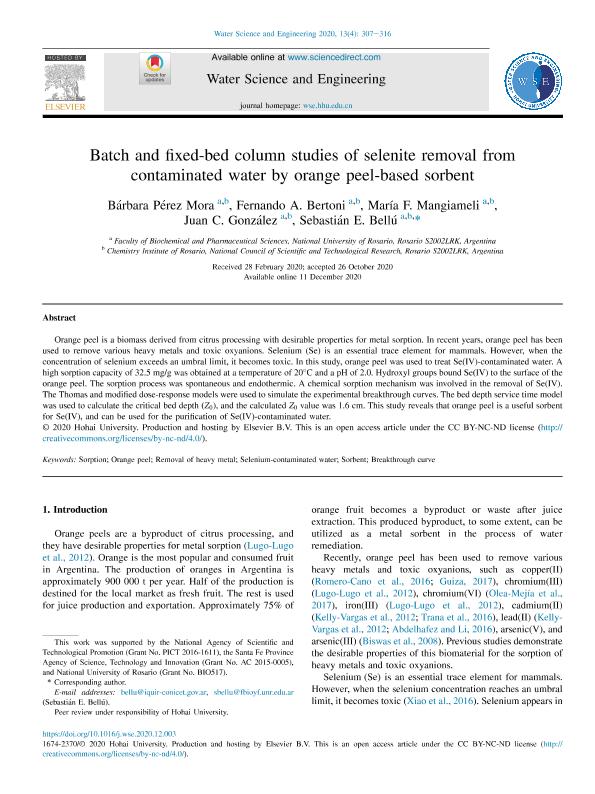Artículo
Batch and fixed-bed column studies of selenite removal from contaminated water by orange peel-based sorbent
Perez Mora, Barbara Edith ; Bertoni, Fernando Ariel
; Bertoni, Fernando Ariel ; Mangiameli, María Florencia; González, Juan Carlos; Bellú, Sebastián Eduardo
; Mangiameli, María Florencia; González, Juan Carlos; Bellú, Sebastián Eduardo
 ; Bertoni, Fernando Ariel
; Bertoni, Fernando Ariel ; Mangiameli, María Florencia; González, Juan Carlos; Bellú, Sebastián Eduardo
; Mangiameli, María Florencia; González, Juan Carlos; Bellú, Sebastián Eduardo
Fecha de publicación:
12/2020
Editorial:
Elsevier
Revista:
Water Science and Engineering
ISSN:
1674-2370
Idioma:
Inglés
Tipo de recurso:
Artículo publicado
Clasificación temática:
Resumen
Orange peel is a biomass derived from citrus processing with desirable properties for metal sorption. In recent years, orange peel has been used to remove various heavy metals and toxic oxyanions. Selenium (Se) is an essential trace element for mammals. However, when the concentration of selenium exceeds an umbral limit, it becomes toxic. In this study, orange peel was used to treat Se(IV)-contaminated water. A high sorption capacity of 32.5 mg/g was obtained at the temperature of 20ºC and a pH of 2.0. Hydroxyl groups took actions to bind Se(IV) to the surface of the orange peel. The sorption process was spontaneous and endothermic. A chemical sorption mechanism was involved in the removal of Se(IV). The Thomas and modified dose-response models were used to simulate the experimental breakthrough curves. The bed depth service time model was used to calculate the critical bed depth ( Z0 ), and the calculated Z0 value was 1.6 cm. This study reveals that orange peel is a useful sorbent for Se(IV), and it is appropriate for the purification of Se(IV)-contaminated water.
Archivos asociados
Licencia
Identificadores
Colecciones
Articulos(IQUIR)
Articulos de INST.DE QUIMICA ROSARIO
Articulos de INST.DE QUIMICA ROSARIO
Citación
Perez Mora, Barbara Edith; Bertoni, Fernando Ariel; Mangiameli, María Florencia; González, Juan Carlos; Bellú, Sebastián Eduardo; Batch and fixed-bed column studies of selenite removal from contaminated water by orange peel-based sorbent; Elsevier; Water Science and Engineering; 13; 4; 12-2020; 307-316
Compartir
Altmétricas



